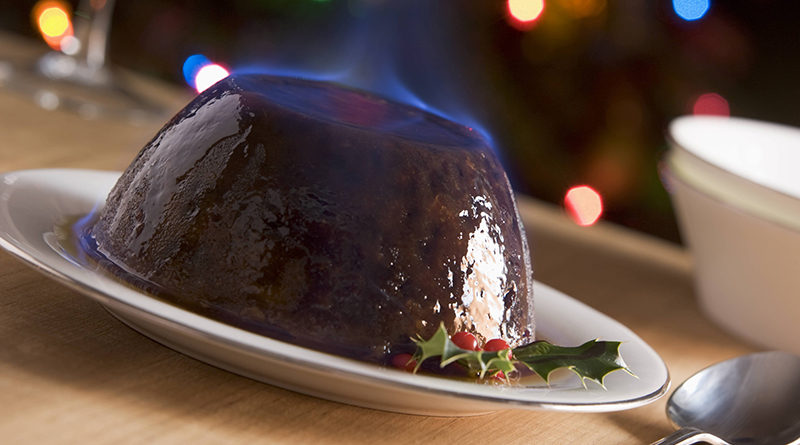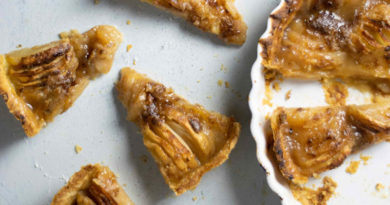Recipe: Christmas pudding
Ohne den traditionellen Weihnachtspudding wäre Weihnachten nicht Weihnachten in Großbritannien. Heutzutage kaufen die meisten Briten ihren Weihnachtspudding im Supermarkt. Es gibt aber auch noch einige, die ihn selbst zubereiten …
By Moya Irvine
How to make a Christmas pudding
In English, a pudding is a cake-like dessert that is cooked – usually steamed – in a bowl. A German “Pudding” is called blancmange in English, or custard if it’s “Vanillepudding”.
For many people in the UK; Christmas isn’t Christmas without a traditional Christmas pudding. Today most Christmas puddings come from the shelves of the supermarket. However, there are still people who enjoy making their own.
There are many different recipes for this traditional dessert. Some include beer; some only have raisins, other have a mixture of dried fruits. Most are made with suet (it’s the fat around a cow’s or sheep’s kidneys!) while others use butter.
There are some interesting customs relating to the Christmas pudding. While the pudding is being made, everyone in the family has a stir and makes a wish. In the middle of the pudding, cooks often place a coin which brings luck to the person who finds it.
If you would like to make a Christmas pudding, it’s a bit late for this year. Traditionally, the puddings are made on “stir-up Sunday” – the last Sunday before Advent. You store the pudding and reheat it on Christmas Day.
The pudding is very, very rich, and it’s quite a challenge to eat one after your Christmas dinner, so you might enjoy it more after a lighter meal.
This recipe is adapted from one on the BBC website and uses butter instead of suet, which is very hard to get in Germany.
Ingredients
• 50g chopped almonds
• 450g mixed dried fruit (sultanas, raisins, currants, chopped dates)
• 1 apple (Boskop or Cox are best), peeled and chopped
• zest and juice of one organic orange
• 3 tablespoons of brandy
• 75g butter
• 100g brown sugar
• 2 eggs
• 100g flour
• half a teaspoon each of nutmeg and cinnamon
• 40g breadcrumbs
Method
1. Put the fruit in a bowl with the juice from the orange and the brandy and mix. Leave to marinate for an hour.
2. Next, put the butter, sugar and orange zest into a large mixing bowl and cream them together with a wooden spoon or whisk. Gradually add the eggs.
3. Add the flour, breadcrumbs, nuts and spices to the butter mixture and fold them in. Add the fruits with the juice and brandy they were marinated in and stir the mixture well.
4. This part is a bit difficult, as you will have to find something that looks like a 1.4 litre china pudding bowl. You can buy these on the internet. When you have found a suitable bowl, butter it and put a small round of baking parchment in the bottom.
5. Spoon your mixture into the bowl and press it down with the back of a spoon. Cover the pudding bowl with baking parchment and tie it tightly with string. There’s a rim on a traditional pudding bowl where you can fit the string.
6. Now you steam your pudding. To do this, you put a metal jam jar lid into the bottom of a large saucepan. You place the bowl on this lid and then fill the saucepan with boiling water until it reaches half way up the pudding bowl. Put a lid on the saucepan and simmer the pudding for about seven hours, checking at intervals to make sure there is still enough water in the saucepan.
7. When the pudding is cooked, store it in a cool dry place until Christmas Day. Then you steam the pudding in its basin as before for about two hours.
Traditionally you place a sprig of holly on the pudding before serving. For a spectacular effect, you can pour over some warm brandy at the table and set light to it, as shown in the photo.
Vocabulary
raisin Rosine – kidney Niere – custom Brauch – to have a stir einmal umrühren – to make a wish sich was wünschen – to store lagern – challenge Herausforderung – ingredient Zutat – chopped gehackt – date Dattel – to peel schälen – zest of orange Orangenschale – organic Bio- – brandy Branntwein – nutmeg Muskatnuss – cinnamon Zimt – breadcrumbs Semmelbrösel – whisk Schneebesen – to fold in unterheben – china Keramik(-) – basin Schüssel – suitable geeignet – baking parchment Backpapier – string Schnur – rim Rand – to steam dämpfen – jam jar Marmeladenglas – saucepan Topf – to simmer köcheln (lassen) – at intervals in Abständen; h.: immer wieder – sprig Zweigchen – holly Stechpalme – to set light to s.th. etw. anzünden
| Photo: Picture Alliance/Monkey Business/Shotshop






